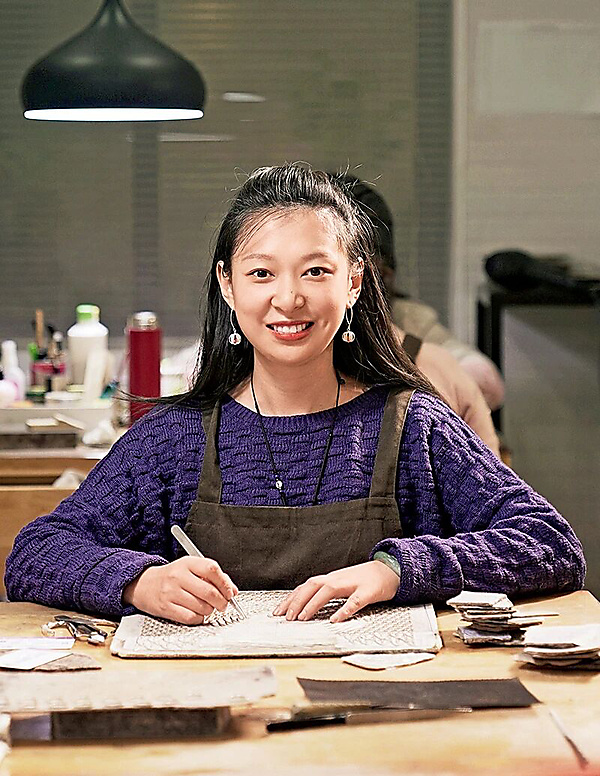Silver filigree refers to the stretching of silver into hair-like threads, and then utilizing the unique threads to form various patterns on crafts. This craft-making skill is widely referred to as one of the "five golden flowers" of folk techniques flourishing in Chengdu, capital of southwest China's Sichuan Province. The other four techniques are Shu embroidery, Shu brocade, lacquer ware and bamboo weaving. In 2008, Chengdu silver filigree was added to the second group of items inscribed on China's list of national intangible cultural heritage.
The tools used to make silver-filigree crafts are basic, and simple: Tweezers, scissors, a high-temperature-resistant asbestos board, a welding torch and a hammer. The silver threads — whether thick or thin — are shaped to form housewares, such as vases, plates, incense containers and boxes. The threads can also be made into ornaments, such as hairpins, eardrops, brooches and bracelets. Makers of the crafts demonstrate their aesthetic tastes, and their excellent skills, by utilizing the delicate, silver threads to both form the shapes and fill the inner designs of the crafts.
Reviving the Craft
Four major steps make up the procedure for manufacturing Chengdu silver filigree. Those steps are: Stretching the threads from a silver ingot; shaping a craft, and filling its inner design with silver threads; high-temperature welding; and, chemical treatment.
Silver, with a high level of purity, is the basic raw material used to make silver-filigree crafts. The hardness and malleability of silver enable the metal to be shaped into long, round bars. Stretching the silver into threads is similar to what an embroiderer does to prepare silk threads before embroidering. A plate — filled with holes, in various diameters — is used to stretch the silver into threads. A meter-long silver bar, as thick as a chopstick, can be stretched into a hair-like thread, the length of which extends 1,000 meters.
When the silver threads are ready, the patterns are placed on a high-temperature-resistant asbestos board, and then, the threads are shaped to the craft and used to fill the craft's inner design.
Chengdu silver filigree highlights the natural texture of silver. High-temperature welding is an important, yet difficult, step, as the various silver threads must be fit together precisely. Silver is easily oxidized, so the last step, chemical treatment, is necessary. Immersing the well-shaped crafts in a chemical reagent, at a constant temperature, will ensure the glossiness of the silver filigree will be maintained for a long time.
Mother, Daughter's Persistence
Dao An, 63, is a national-level inheritor of Chengdu silver filigree. She runs a studio in Chengdu. Since she began training as a silver-filigree craftswoman, at a gold and silver products plant when she was 18, Dao has dedicated herself to the manufacturing of silver-filigree crafts.
 |
| Dao An, a national-level inheritor of Chengdu silver filigree |
 |
| Wang Xiaolu, Dao An's daughter |
Dao developed an interest in drawing when she was young. She took regular drawing classes, at night school, when she was a middle school student. She was hired by the gold and silver products plant in 1980. Dao, who was excellent at drawing and designing, eventually began focusing on making silver-filigree products. Near the end of the 1990s, Dao established her own studio, in Chengdu.
In 2008, Dao's daughter, Wang Xiaolu, became a second-generation inheritor of Chengdu silver filigree. When Wang was in college, she took an optional course in tourism-craft design and manufacturing. She tried designing silver-filigree earrings, eardrops and other accessories. Initially, she wore her silver accessories; later, she sold her crafts at an intangible-cultural-heritage market. Now, Dao's studio has space dedicated to displaying silver-filigree accessories. Wang is in charge of that section. Wang has integrated the manufacturing of silver-filigree crafts with several other decoration skills, such as embossing, enameling and gem mounting.
Dao and Wang's studio in recent years has attracted many apprentices and customers, who have placed orders for crafts produced in the studio. Dao and Wang have attended intangible-cultural-heritage expos and cultural events to promote Chengdu's silver-filigree crafts. Their studio offers craft-making classes and training sessions to cultivate the next generation of inheritors and artisans.
"I hope there will be more young people who are willing to learn and love this art," Dao says. "They will pass down the traditional skill, with their new ideas."
Photos from Dao An and Wang Xiaolu
(Women of China English Monthly September 2025)
Executive Editor: Ye Shan